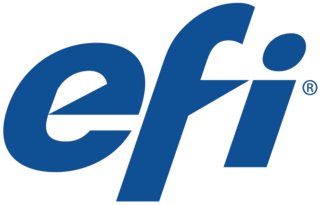
In computer graphics and digital photography, a raster graphic represents a two-dimensional picture as a rectangular matrix or grid of pixels, viewable via a computer display, paper, or other display medium. A raster is technically characterized by the width and height of the image in pixels and by the number of bits per pixel. Raster images are stored in image files with varying dissemination, production, generation, and acquisition formats.

An MFP, multi-functional, all-in-one (AIO), or multi-function device (MFD), is an office machine which incorporates the functionality of multiple devices in one, so as to have a smaller footprint in a home or small business setting, or to provide centralized document management/distribution/production in a large-office setting. A typical MFP may act as a combination of some or all of the following devices: email, fax, photocopier, printer, scanner.

Graham William Nash is an English-American musician, singer and songwriter. He is known for his light tenor voice and for his contributions as a member of the Hollies and Crosby, Stills & Nash.
Digital intermediate (DI) is a motion picture finishing process which classically involves digitizing a motion picture and manipulating the color and other image characteristics.

Giclée describes digital prints intended as fine art and produced by inkjet printers. The term is a neologism, ultimately derived from the French word gicleur, coined in 1991 by printmaker Jack Duganne. The name was originally applied to fine art prints created on a modified Iris printer in a process invented in the late 1980s. It has since been used widely to mean any fine-art printing, usually archival, printed by inkjet. It is often used by artists, galleries, and print shops for their high quality printing, but is also used generically for art printing of any quality.

Digital printing is a method of printing from a digital-based image directly to a variety of media. It usually refers to professional printing where small-run jobs from desktop publishing and other digital sources are printed using large-format and/or high-volume laser or inkjet printers.
The Computer Animation Production System (CAPS) was a proprietary collection of software, scanning camera systems, servers, networked computer workstations, and custom desks developed by The Walt Disney Company and Pixar in the late 1980s. Although outmoded by the mid-2000s, it succeeded in reducing labor costs for ink and paint and post-production processes of traditionally animated feature films produced by Walt Disney Animation Studios (WDAS). It also provided an entirely new palette of digital tools to the animation filmmakers.
The Cineon System was one of the first computer based digital film systems, created by Kodak in the early 1990s. It was an integrated suite of components consisting a Motion picture film scanner, a film recorder and workstation hardware with software for compositing, visual effects, image restoration and color management.
An Iris printer is a large-format color inkjet printer designed for prepress proofing. It was introduced in 1985 by Iris Graphics, originally of Stoneham, Massachusetts, and is currently manufactured by the Graphic Communications Group of Eastman Kodak. It is also used in the fine art reproduction market as a final output digital printing press, as in Giclée.

An optical printer is a device consisting of one or more film projectors mechanically linked to a movie camera. It allows filmmakers to re-photograph one or more strips of film. The optical printer is used for making special effects for motion pictures, or for copying and restoring film material.

Virtual cinematography is the set of cinematographic techniques performed in a computer graphics environment. It includes a wide variety of subjects like photographing real objects, often with stereo or multi-camera setup, for the purpose of recreating them as three-dimensional objects and algorithms for the automated creation of real and simulated camera angles. Virtual cinematography can be used to shoot scenes from otherwise impossible camera angles, create the photography of animated films, and manipulate the appearance of computer-generated effects.
Information International, Inc., commonly referred to as Triple-I or III, was an early computer technology company.
Canon Production Printing, known as Océ until the end of 2019, is a Netherlands-based subset of Canon that develops, manufactures and sells printing and copying hardware and related software. The product line includes office printing and copying machinery, production printers, and wide-format printers for both technical documentation and color display graphics.

A canvas print is the result of an image printed onto canvas which is often stretched, or gallery-wrapped, onto a frame and displayed. Canvas prints are used as the final output in an art piece, or as a way to reproduce other forms of art.

SilverFast is the name of a family of software for image scanning and processing, including photos, documents and slides, developed by LaserSoft Imaging.
Jon Cone is a collaborative printmaker, pioneer and developer of photographic ink jet technologies, educator, and photographer. Cone is best known for the founding of the world's first digital printmaking studio, Cone Editions Press and developer of quad-black ink jet systems for printing fine black-and-white photographs including the first commercially available method of producing fine art black-and-white prints in the digital darkroom.

Electronics for Imaging, Inc. (EFI) is an international company based in Silicon Valley that specializes in digital printing technology. Formerly located in Foster City, California, the company is now based in Fremont. On July 1, 2015, EFI entered the textile printing marketing with the acquisition of Italian digital textile company Reggiani Macchine. On June 16, 2016, EFI acquired Optitex, a 3D digital workflow provider.

In 3D computer graphics, 3D modeling is the process of developing a mathematical coordinate-based representation of a surface of an object in three dimensions via specialized software by manipulating edges, vertices, and polygons in a simulated 3D space.










